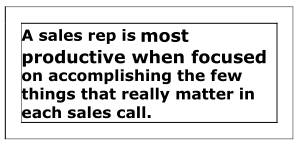In order to reconnect sales management to profitability, address each of the points of breakdown. Managers can do this through a five-step process.
Understand profitability: A surprisingly frequent underlying reason why the sales force does not succeed in maximizing company profitability is that the senior managers themselves do not have a clear understanding of the company’s key profitability drivers. This makes it impossible for them to communicate to the sales force clear, implementable objectives and systematic procedures to accomplish them.
Some senior managers feel there is no time to analyze and understand the factors affecting profitability, and to devise concrete measures to guide managers in their efforts to maxi- mize profits. This is a major error.

The core responsibilities of senior management are to set strategy and objectives, secure resources, and maximize profitability. It is imperative that top managers have a deep enough knowledge of profitability management to be able to communicate that wisdom to the sales force. It is futile to simply instruct the sales force to produce the most profitable results.
Translate into business objectives: All companies have business plans, but often these plans, which feature mainly company and market analysis, sets of programs, and numbers, are not adequate to guide a sales force.
The core questions that must be addressed every day by the sales reps and sales managers are who to call on and what each calls needs to accomplish. A sales rep can accomplish a limited number of things, such as increasing sales in an existing account, changing a customer’s product mix, up-selling, cross-selling, obtaining a new customer, minimizing discounts, minimizing returns, etc. Effective business plans must give guidance to the sales force about which objectives they should pursue in given situations in order to produce the highest payoffs. The sales reps cannot maximize everything.
Effective business plans have three essential roles: first, to state clearly the company’s objectives; second, to specify new initiatives, required resources, and expected results; and third, to guide the day-to-day activities of the company toward maxi- mum profitability. In most companies, the first objective is usually met, the second is sometimes met, and the third is often neglected. When this occurs, it causes the sales force to become disconnected from profitability.
Communicate the business objectives: In some companies, business objectives and plans are simply not communicated to the sales force. They are created by department heads or staff, and shared only with upper and middle-level managers. Sometimes business plans are considered confidential. This causes the sales force to be disconnected.
There is a parable about three bricklayers who are asked what they are doing: the first replies, “laying bricks,” the second replies, “building a wall,” and the third replies, “building a cathedral.” In the absence of an understanding of business objectives that guide profitability maximization, the sales force is simply laying bricks. They never see the cathedral, and the company loses the inspired performance.
In effective companies, the top managers communicate the company’s objectives to the sales force. If the objectives have changed, they explain the decision and why the new objectives are good for the company, the customers, and the sales force. They do not hand off to the head of sales the responsibility for this vital communication.
This direct communication creates two important benefits. First, because most top managers have a deeper understanding of the factors that create profitability across the company, they are able to communicate the nuances of how to maximize the company’s profitability in the everyday decision-making that is the heart of the sales process, and they can communicate why this is important to the sales force and the company. Second, the mere fact that the top managers personally communicate the objectives to the sales force strongly underlines their commitment to accomplishing these goals. By demonstrating that they have taken the time to understand and explain how to maximize profitability, these top managers display the “body language” that motivates the sales force.

Translate into a compensation plan: In some companies, objectives are changed each year, or more frequently, with little or no change in the compensation plan. There is an old saying that a person can understand a vision and can buy into the vision, but in the end will do what you pay him to do.
Conversely, if a person does not understand how to accomplish the vision, it does not do a lot of good to tie her compensation to its realization. The difficulty with tailoring an effective sales compensation plan is that it requires a set of well-thought-out business objectives that are specific enough to guide the sales force every day. The sales force should be driven by the compensation plan. “Work your pay plan” is one of the central tenets of sales management. Simply telling the sales reps to maximize profitability without giving them an understanding of how to do this, and compensating them to do this, will render the compensation plan largely ineffective.
Sometimes, the sales force is asked to maximize many objectives, or a set of objectives that cannot be simultaneously maximized. In these cases, the sales force defaults to the simplest way to maximize their compensation. Sales compensation is so critical to a company’s success that top management should directly review the plan.
Create individual sales plans: In many companies, sales plans for individual sales reps do not exist or are too vague. This is like writing a paper without taking the time to develop an effective outline. For example, a rep may simply plan to increase revenues by a certain percent for a cluster of accounts. This is a hope, not a plan. By contrast, an effective individual sales plan must be specified at the account/product level, so the rep and sales manager can track progress and continuously improve the rep’s performance.
The building blocks for a tightly-connected sales force are three- fold: 1) clear business plans, which include guidance on what to do to maximize profitability in particular types of situations, and which reflect top management clarity and commitment; 2) compensation that has been tailored to direct the sales reps to meet the company’s objectives; and 3) well-specified account plans that will enable the reps to fulfill the business objectives and allow the sales managers to monitor and coach the reps’ progress. These plans must be developed by the individual sales reps, and include step-by-step, account-specific initiatives to obtain new accounts, to increase penetration in existing accounts, and to increase account profitability.
Every aspect of the account plans should be measurable. They should provide specific answers to the questions: Where will I get sales? How will I get sales? How will I meet my objectives and the company’s objectives? How will I make money? Well-specified account plans provide the basis for management coaching. They also protect the company against losing sales in the event of rep turnover.
Here’s an example of the power of effective account plans. The top management of a company had looked carefully at its profitability and sales force productivity. It determined that the highest-payoff sales objective was to “turn around” high potential, under penetrated accounts that were clustered in areas that minimized installation costs. However, the reps were focused on increasing revenues in a vague way, and consequently spent inordinate amounts of time with “easy” or “friendly” accounts, many of which were only marginally profitable to serve.

In order to increase sales force productivity, top management devised a clear set of business plans to guide the reps in account selection and managing their time. They helped the sales manager’s work with the reps to identify the highest-potential underperforming accounts in each territory, and to create step-by-step account plans to map the buying center and systematically position the company for the sale. Management understood that turning around an account could be a three-month process, and set up milestones to monitor progress with compensation tied to achieving specific milestones. Sales managers coached the reps account-by-account, milestone by milestone.
The initiative was extremely effective, with sales increasing by more than 30 percent in a number of target accounts within a month. Top management had succeeded in reconnecting the sales force to profitability.

